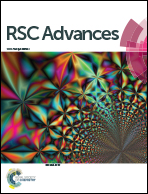Novel NLO-phores containing dihexyl amino benzo[b]thiophene exhibiting good transparency and enhanced electro-optical activity†
Abstract
Two new chromophores (A and B) were synthesized, in which a benzo[b]thiophene moiety was first introduced as a donor group. To investigate the macroscopic EO activity of the new chromophores, guest–host doped polymer films were fabricated by doping chromophores A and B into amorphous polycarbonate (APC). The poled films containing A with a loading density of 20 wt% achieved a maximum EO coefficient (r33) of 42 pm V−1 at 1310 nm, while for the poled films containing B, the r33 value is 75 pm V−1 at 1310 nm. UV-vis spectral absorption of the new chromophores were studied in solutions and films, and chromophores A and B showed a maximum absorption in chloroform of 658 nm and 688 nm, respectively. Compared to the FTC (r33 = 20–50 pm V−1 at 1310 nm, λmax = 685 nm in chloroform) analogues, they exhibited enhanced electro-optical activity together with a high optical gap. This new type of chromophore provided better optimization of the nonlinearity-transparency trade-off.
![Graphical abstract: Novel NLO-phores containing dihexyl amino benzo[b]thiophene exhibiting good transparency and enhanced electro-optical activity](/en/Image/Get?imageInfo.ImageType=GA&imageInfo.ImageIdentifier.ManuscriptID=C4RA00883A&imageInfo.ImageIdentifier.Year=2014)

 Please wait while we load your content...
Please wait while we load your content...